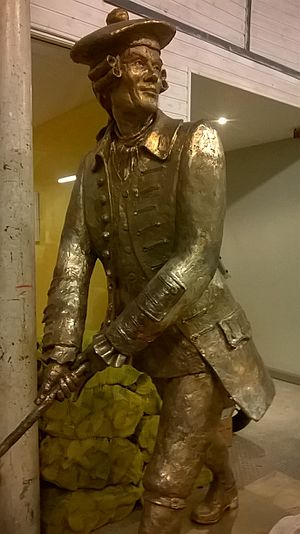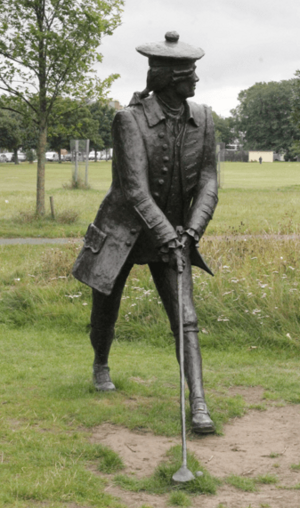John Rattray (surgeon) facts for kids
Quick facts for kids
John Rattray
|
|
|---|---|

Bronze life-sized figure of John Rattray
|
|
| Born | 22 September 1707 Craighall Castle, Rattray, Perthshire, Scotland
|
| Died | 5 July 1771 (aged 63) Edinburgh, Scotland
|
| Nationality | Scottish |
| Occupation | Surgeon |
| Known for | Signing the first rules of golf. Surgeon to Prince Charles Edward Stuart |

John Rattray (born September 22, 1707 – died July 5, 1771) was a surgeon from Edinburgh, Scotland. He is best known for his amazing skills in golf. He also served as a surgeon for Prince Charles Edward Stuart during the Jacobite rising of 1745.
John Rattray was a very good archer, winning the Edinburgh Arrow twice. But it's his golf achievements that people remember most. He was such a skilled golfer that he won the first competition held by the Company of Gentleman Golfers. This group later became known as the Honourable Company of Edinburgh Golfers. After winning, he became the 'Captain of Goff' for a year. In this important role, he signed the very first Rules of Golf.
Contents
Early Life and Becoming a Surgeon
John Rattray was born on September 22, 1707. His birthplace was Craighall Castle in Perthshire, Scotland. This castle was the home of his family, Clan Rattray. His father, Thomas Rattray, was a religious leader.
Since John was the second son, he didn't inherit the family estate. So, he chose a different path. He decided to become a surgeon. From 1728 to 1735, he trained in Edinburgh. After his training, he started working as a surgeon in the city. In 1740, he became a full member of the Incorporation of Surgeons of Edinburgh. This group later became the Royal College of Surgeons of Edinburgh.
John Rattray's Sporting Talents
John Rattray loved sports and was very good at them. In 1731, he joined the Royal Company of Archers. He won their silver punch bowl archery competition four times. He also won the Edinburgh Arrow twice, in 1735 and 1744. This was a very important archery prize.
But golf was where he truly shined. His golfing skills were even written about in a poem! The poem, called 'The Goff,' was published in 1743. It was the first poem ever written about golf. It described him as "Rattray for skill."
The poem talks about a famous golf course called Leith Links. This was a grassy area near Edinburgh where the 'Company of Gentleman Golfers' played often. One of Rattray's regular golf friends was Duncan Forbes, Lord Culloden. He was a very important judge in Scotland. Their friendship would later help save Rattray's life.
The First Rules of Golf
The Gentleman Golfers wanted to have an annual golf competition. They asked the Edinburgh Town Council to give them a silver club as a prize. The Town Council agreed on March 7, 1744. They also set up rules for how the competition would work.
The golfers had already written down their own "Articles and Laws in playing at golf." These were the original rules of golf. The competition was played on five holes at Leith Links. It's thought they played three rounds of this course.
On April 2, 1744, John Rattray won this first competition. He won the silver club and was named 'Captain of the Goff'. His signature is found below the 13 original rules of golf. These rules are in the minute book of the Honourable Company of Edinburgh Golfers.
It's not fully clear if he wrote the rules himself or if he just signed them as the captain. He wrote 'Cptn' after his name, which suggests he signed as captain. Many people believe the rules were a team effort by the golfers. These original rules were found in 1937. They are now kept at the National Library of Scotland. The golfers in St Andrews later used these rules, with small changes, in 1754. They still form the basis of many modern golf rules today.
Role in the 1745 Jacobite Rising
In 1745, Prince Charles Edward Stuart started a rebellion. He wanted to claim the British throne for his father. John Rattray joined the Jacobite army after a battle in September. Surgeons from Edinburgh were asked to help the wounded.
Rattray became the Surgeon-general and personal surgeon to Prince Charles. After a major battle, Rattray surrendered. He was put in prison in Inverness.
A Hanoverian officer teased Rattray, saying, "We know well what you are sir, the Pretender’s surgeon. If anyone hangs you shall." But Rattray's golf friend, Duncan Forbes, Lord Culloden, stepped in. Forbes was loyal to the King. He asked for Rattray to be set free. His plea worked! Rattray was released, but later rearrested in Edinburgh. He was held in London until January 1747. He was finally freed after promising loyalty to the King.
Later Life and Legacy
After his release, John Rattray went back to being a surgeon in Edinburgh. He also returned to playing golf. In 1751, he won the golf competition for the silver club again. He continued working as a surgeon until at least 1766.
John Rattray passed away in Edinburgh on July 5, 1771. He was buried in Greyfriars Kirkyard in Edinburgh.
Statue on Leith Links
In 2013, the Leith Rules Golf Society decided to honor John Rattray. They got permission to build a life-sized statue of him on Leith Links. They hired sculptor David Annand for the project.
The bronze statue was unveiled on September 11, 2019. It stands in a special area on the north side of the original Golf Course on Leith Links. This statue celebrates John Rattray's important contributions to the game of golf.
Images for kids


